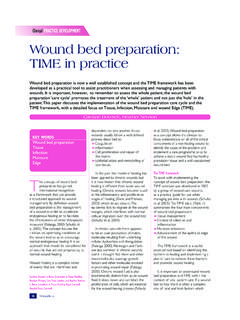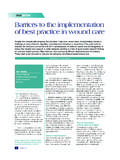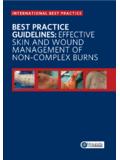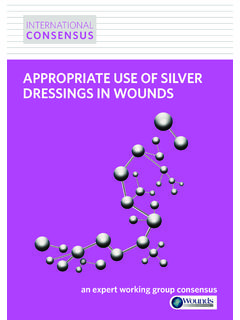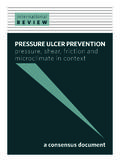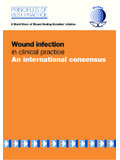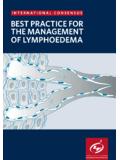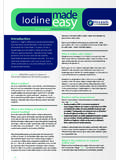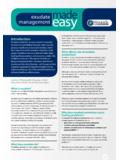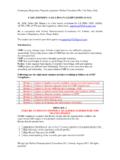Transcription of Hard-to-healmadeeasy wounds
1 hard -to-heal made wounds easy Volume 2 | Issue 4 | November 2011 Box 1 Factors for delayed healing9. Introduction n Patient-related factors (eg underlying pathology/comorbidities, Most people have, at some stage in their life, severe pain, psychological factors, gender and reduced mobility). n Wound-related factors (eg ulcer size >10cm2, ulcer duration >6. experienced a wound. For the majority, healing months, anatomical location and wound bed condition). n Clinical competency factors (eg skills and knowledge of is a simple and rapid process and, although the healthcare professional). wound may leave a visible scar, it is not associated n Resources and treatment-related factors (eg availability and suitability). with persistent pain, excessive exudate, odour or distress. In some patients, healing is prolonged and What factors affect healing?
2 Accompanied by major symptoms, which adversely Wound aetiology, patient age and the presence of significant affects their quality of life. Clinicians therefore face comorbidities all impact on the healing process, as do factors such the dual challenge to meet patient expectations as wound size and depth, location of the wound, wound duration of prompt and trouble-free wound healing, and to and the presence of a heavy bioburden9. recognise and act appropriately for those patients Age and hard -to-heal wounds in which wound healing may be prolonged. Age affects healing in a number of ways. Elderly patients tend to have significant comorbidities and are more likely to be on multiple Author: Vowden P. Full author details can be found medications, which impact on healing. Ageing itself also affects on page 6. both the rate and quality of the healing process.
3 Large wounds often take longer to heal than small wounds and, as such, are more likely What is a hard -to-heal wound? to develop complications such as infection, which may then slow A hard -to-heal wound has been defined as one that fails to heal healing9. For chronic wounds , size may relate to the severity of the with standard therapy in an orderly and timely manner1. This underlying causative condition and the status of the surrounding definition applies equally to both acute and chronic wounds and is skin, both of which have the potential to delay healing. In addition, independent of the wound type and aetiology. the persistent inflammatory process associated with non-healing and long wound duration degrades the extracellular matrix and Many wounds , particularly those in an elderly population with vascular supply to the wound, resulting in poor cellular function and significant comorbidities, prove challenging to manage.
4 Audit senescence a loss of a cell's power to divide and grow9. data from both Bradford2-5 and Hull6,7 has demonstrated that delayed healing occurs in a variety of wound types. Although Comorbidities: diabetes delayed healing appears to be common, it is frequently not Patients with hard -to-heal wounds may have a number of comorbid recognised early enough and can pose a major problem, conditions that affect the healing process. Diabetes is a significant increasing clinical workloads and cost. factor and can affect healing in the following ways: n Cell membrane structure may be altered, affecting cell motility and deformability and the cellular response to local Why do some wounds not heal? and systemic signalling proteins One of the characteristics of multi-celled organisms is the ability n The extracellular membrane may be damaged by non- to replicate and self-repair.
5 The normal healing process is a well- enzymatic glycosylation, affecting both its structure and orchestrated, complex and interlinked series of four well-recognised function overlapping phases. n The inflammatory response and response to infection may be modified by changes in both chemotaxic and phagocytic Normal healing function of white cells The process starts with haemostasis, progresses through a n The blood supply to the wound area may be reduced by destructive inflammatory phase and then a restorative proliferative both occlusive arterial disease, changes in the distribution phase. It finishes with remodelling of the wound area. In this process, of blood flow (shunting) and a reduction in angiogenesis components of the extracellular matrix, interacting with recruited function (the growth of new blood vessels) affecting the cells, play an important role in coordinating key processes in healing8.
6 Ingrowth of new blood vessels to the wound The normal process can be interrupted at any stage and is vulnerable n The presence of a neuropathy allowing ongoing trauma to to a variety of intrinsic and extrinsic inhibitory factors. the wounded area. 1. made easy hard -to-heal wounds Ischaemia n Ischaemia As described, wound healing is dependent on cell replication, n Infection the formation of a new supporting matrix and the elimination n Abnormal or persistent inflammation. of damaged, necrotic, foreign or infecting material. All of these processes are energy dependent and only occur effectively in In addition, the presence of exposed bone or tendon, on which it the presence of an adequate blood supply and the delivery of is difficult to establish healthy granulation tissue, are recognised nutrients and oxygen to the wounded area.
7 As obstacles to rapid wound healing11,12. This process is impaired in the presence of systemic disease The more complex the wound in relation to the underlying (cardiac and respiratory failure), regional ischaemia (peripheral pathology and comordibites, the greater the likelihood that the vascular disease) and local ischaemia within the wound, wound will be hard to heal9. secondary to poor neo-vascularisation and angiogenesis. Biomarkers to predict hard -to-heal wounds Infection and Inflammation A non-healing wound contains a number of microbial, Inflammation is a necessary component of the healing process, biochemical and cellular abnormalities that will prevent or slow but is detrimental if it continues at an inappropriate level the healing progression. This often occurs despite a seemingly beyond the initial phases of healing, or is stimulated by other adequate wound bed.
8 As our knowledge of the processes and events such as infection within a wound. Diseases such as biochemistry of wound healing has progressed, it has become rheumatoid arthritis and medication (eg steroids) alter the clear that, in a number of non-healing wounds , a range of inflammatory process. This can have a detrimental effect on biomarkers are abnormal and that some wounds are locked' into healing. a self-perpetuating inflammatory process. Diabetic patients, for example, experience a substantial deficit in wound healing with Other factors a marked pro-inflammatory reaction13. The reason for delayed healing may not be related solely to an abnormality within the wound itself (Box 1). Available healthcare Assessment of acute wound fluid and chronic wound exudate resources, product availability and the skill and knowledge has shown marked differences between the wound fluid from of healthcare professionals may also influence outcome and the two wound types.
9 Exudate from non-healing chronic healing time, as will the complexity of the wound itself9. wounds has been reported to have destructive properties, with abnormally high levels of proteases and reduced levels of important growth factors14. If left unchecked, sustained excessive Can you predict when a wound is hard protease activity in wounds start to destroy the extracellular to heal? matrix and damage newly formed tissue, preventing the wound In most wounds , healing progress should be visible within a from progressing to the proliferative stage15. four-week period1. Figure 1 outlines the process of recognising a hard -to-heal wound and provides a useful check list to allow The recognition that metalloproteases (MMPs) constitute one for the early identification of potentially slow healing wounds . group of potential markers for delayed healing has led to work developing a point-of-care diagnostic15 and targeted therapeutic Much can be gleaned from a detailed initial wound and interventions16 that may assist in the management of hard -to-heal patient assessment when issues such as ischaemia, associated wounds .
10 Ongoing work has identified other potential biochemical comorbidities and infection, amongst others, may be markers for delayed healing that may allow other targeted identified and a broad idea of healing potential derived. Such advanced wound therapies to be developed in the future. Molecular assessments must, however, be accurate and reproducible if pathogen diagnostics now allow a comprehensive evaluation of treatment is to be delivered effectively10. the microbial bioburden17, and targeted interventions based on this data have been shown to improve outcome18. It remains to be seen Recognition of non-healing demands a careful reassessment how clinically and cost-effective such interventions will be and how of both the wound, the region of the wound, the patient and early in the cycle of healing/non-healing, persistent biochemical the systems of care so that both extrinsic and intrinsic barriers abnormalities can be detected.
